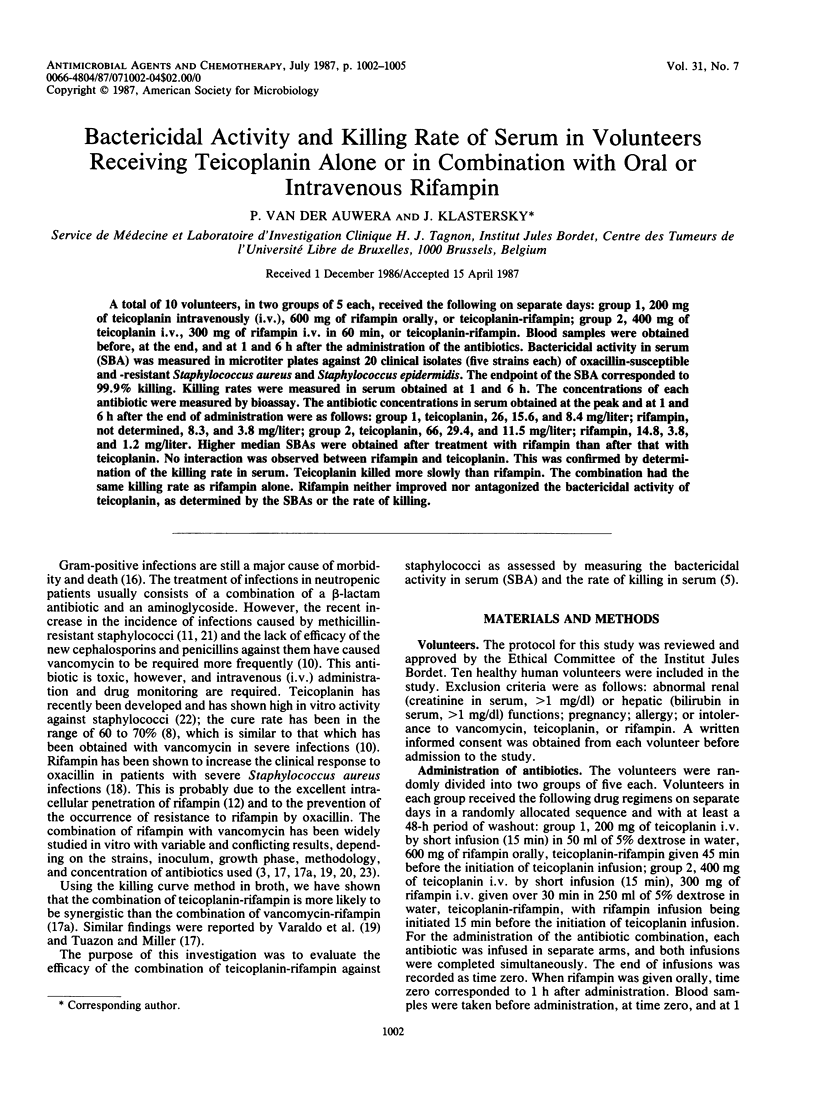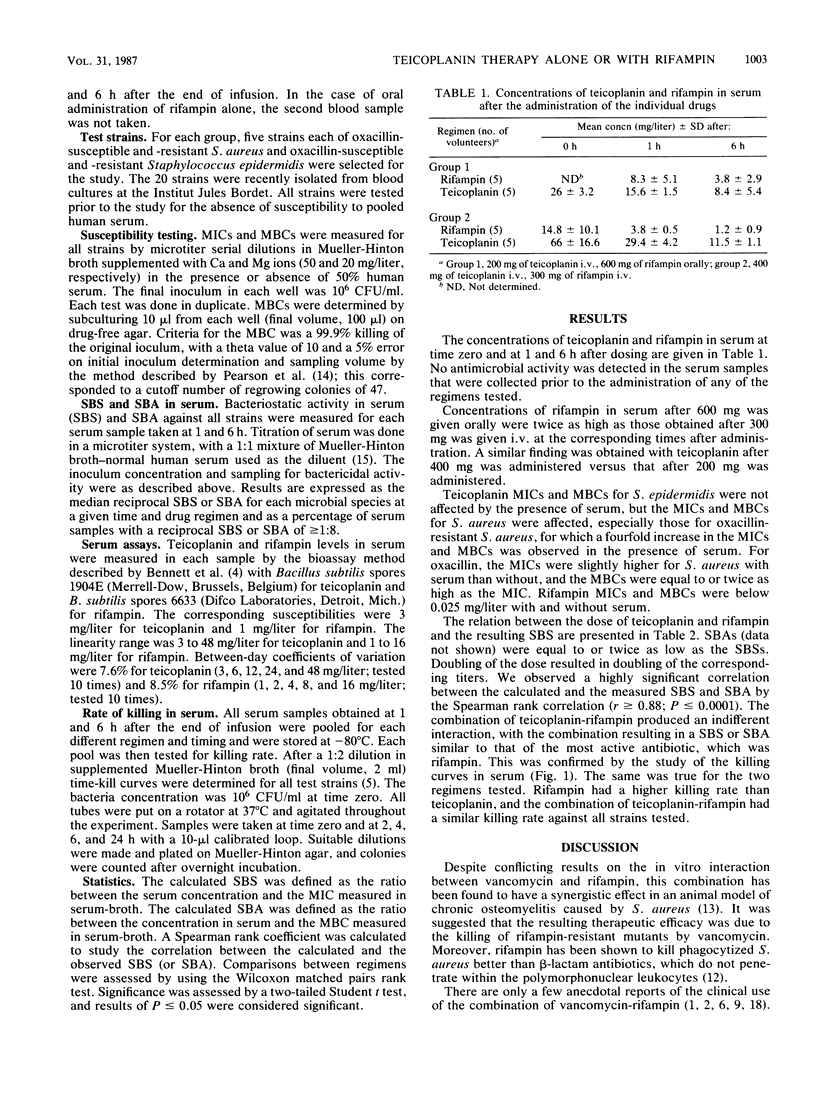Abstract
A total of 10 volunteers, in two groups of 5 each, received the following on separate days: group 1,200 mg of teicoplanin intravenously (i.v.), 600 mg of rifampin orally, or teicoplanin-rifampin; group 2,400 mg of teicoplanin i.v., 300 mg of rifampin i.v. in 60 min, or teicoplanin-rifampin. Blood samples were obtained before, at the end, and at 1 and 6 h after the administration of the antibiotics. Bactericidal activity in serum (SBA) was measured in microtiter plates against 20 clinical isolates (five strains each) of oxacillin-susceptible and-resistant Staphylococcus aureus and Staphylococcus epidermidis. The endpoint of the SBA corresponded to 99.9% killing. Killing rates were measured in serum obtained at 1 and 6 h. The concentrations of each antibiotic were measured by bioassay. The antibiotic concentrations in serum obtained at the peak and at 1 and 6 h after the end of administration were as follows: group 1, teicoplanin, 26, 15.6, and 8.4 mg/liter; rifampin, not determined, 8.3, and 3.8 mg/liter; group 2, teicoplanin, 66, 29.4, and 11.5 mg/liter; rifampin, 14.8, 3.8, and 1.2 mg/liter. Higher median SBAs were obtained after treatment with rifampin than after that with teicoplanin. No interaction was observed between rifampin and teicoplanin. This was confirmed by determination of the killing rate in serum. Teicoplanin killed more slowly than rifampin. The combination had the same killing rate as rifampin alone. Rifampin neither improved nor antagonized the bactericidal activity of teicoplanin, as determined by the SBAs or the rate of killing.
Full text
PDF



Selected References
These references are in PubMed. This may not be the complete list of references from this article.
- Acar J. F., Goldstein F. W., Duval J. Use of rifampin for the treatment of serious staphylococcal and gram-negative bacillary infections. Rev Infect Dis. 1983 Jul-Aug;5 (Suppl 3):S502–S506. doi: 10.1093/clinids/5.supplement_3.s502. [DOI] [PubMed] [Google Scholar]
- Archer G. L., Tenenbaum M. J., Haywood H. B., 3rd Rifampin therapy of Staphylococcus epidermidis. Use in infections from indwelling artificial devices. JAMA. 1978 Aug 25;240(8):751–753. [PubMed] [Google Scholar]
- Bayer A. S., Morrison J. O. Disparity between timed-kill and checkerboard methods for determination of in vitro bactericidal interactions of vancomycin plus rifampin versus methicillin-susceptible and -resistant Staphylococcus aureus. Antimicrob Agents Chemother. 1984 Aug;26(2):220–223. doi: 10.1128/aac.26.2.220. [DOI] [PMC free article] [PubMed] [Google Scholar]
- Bennett J. V., Brodie J. L., Benner E. J., Kirby W. M. Simplified, accurate method for antibiotic assay of clinical specimens. Appl Microbiol. 1966 Mar;14(2):170–177. doi: 10.1128/am.14.2.170-177.1966. [DOI] [PMC free article] [PubMed] [Google Scholar]
- Drake T. A., Hackbarth C. J., Sande M. A. Value of serum tests in combined drug therapy of endocarditis. Antimicrob Agents Chemother. 1983 Nov;24(5):653–657. doi: 10.1128/aac.24.5.653. [DOI] [PMC free article] [PubMed] [Google Scholar]
- Faville R. J., Jr, Zaske D. E., Kaplan E. L., Crossley K., Sabath L. D., Quie P. G. Staphylococcus aureus endocarditis. Combined therapy with vancomycin and rifampin. JAMA. 1978 Oct 27;240(18):1963–1965. doi: 10.1001/jama.240.18.1963. [DOI] [PubMed] [Google Scholar]
- Fietta A., Sacchi F., Bersani C., De Rose V., Grassi F., Gialdroni Grassi G. Effetto di antibiotici glicopeptidici sull'attività dei fagociti umani. G Ital Chemioter. 1982 Jan-Jun;29(1):11–14. [PubMed] [Google Scholar]
- Karchmer A. W., Archer G. L., Dismukes W. E. Rifampin treatment of prosthetic valve endocarditis due to Staphylococcus epidermidis. Rev Infect Dis. 1983 Jul-Aug;5 (Suppl 3):S543–S548. doi: 10.1093/clinids/5.supplement_3.s543. [DOI] [PubMed] [Google Scholar]
- Klastersky J., Coppens L., van der Auwera P., Meunier-Carpentier F. Vancomycin therapy of oxacillin-resistant Staphylococcus aureus infections. J Antimicrob Chemother. 1983 Apr;11(4):361–367. doi: 10.1093/jac/11.4.361. [DOI] [PubMed] [Google Scholar]
- Levine D. P., Cushing R. D., Jui J., Brown W. J. Community-acquired methicillin-resistant Staphylococcus aureus endocarditis in the Detroit Medical Center. Ann Intern Med. 1982 Sep;97(3):330–338. doi: 10.7326/0003-4819-97-3-330. [DOI] [PubMed] [Google Scholar]
- Mandell G. L., Vest T. K. Killing of intraleukocytic Staphylococcus aureus by rifampin: in-vitro and in-vivo studies. J Infect Dis. 1972 May;125(5):486–490. doi: 10.1093/infdis/125.5.486. [DOI] [PubMed] [Google Scholar]
- Norden C. W., Shaffer M. Treatment of experimental chronic osteomyelitis due to staphylococcus aureus with vancomycin and rifampin. J Infect Dis. 1983 Feb;147(2):352–357. doi: 10.1093/infdis/147.2.352. [DOI] [PubMed] [Google Scholar]
- Pearson R. D., Steigbigel R. T., Davis H. T., Chapman S. W. Method of reliable determination of minimal lethal antibiotic concentrations. Antimicrob Agents Chemother. 1980 Nov;18(5):699–708. doi: 10.1128/aac.18.5.699. [DOI] [PMC free article] [PubMed] [Google Scholar]
- Reller L. B., Stratton C. W. Serum dilution test for bactericidal activity. II. Standardization and correlation with antimicrobial assays and susceptibility tests. J Infect Dis. 1977 Aug;136(2):196–204. doi: 10.1093/infdis/136.2.196. [DOI] [PubMed] [Google Scholar]
- Sculier J. P., Weerts D., Klastersky J. Causes of death in febrile granulocytopenic cancer patients receiving empiric antibiotic therapy. Eur J Cancer Clin Oncol. 1984 Jan;20(1):55–60. doi: 10.1016/0277-5379(84)90034-8. [DOI] [PubMed] [Google Scholar]
- Tuazon C. U., Miller H. Comparative in vitro activities of teichomycin and vancomycin alone and in combination with rifampin and aminoglycosides against staphylococci and enterococci. Antimicrob Agents Chemother. 1984 Apr;25(4):411–412. doi: 10.1128/aac.25.4.411. [DOI] [PMC free article] [PubMed] [Google Scholar]
- Van der Auwera P., Joly P. Comparative in-vitro activities of teicoplanin, vancomycin, coumermycin and ciprofloxacin, alone and in combination with rifampicin or LM 427, against Staphylococcus aureus. J Antimicrob Chemother. 1987 Mar;19(3):313–320. doi: 10.1093/jac/19.3.313. [DOI] [PubMed] [Google Scholar]
- Van der Auwera P., Klastersky J., Thys J. P., Meunier-Carpentier F., Legrand J. C. Double-blind, placebo-controlled study of oxacillin combined with rifampin in the treatment of staphylococcal infections. Antimicrob Agents Chemother. 1985 Oct;28(4):467–472. doi: 10.1128/aac.28.4.467. [DOI] [PMC free article] [PubMed] [Google Scholar]
- Van der Auwera P., Meunier-Carpentier F., Klastersky J. Clinical study of combination therapy with oxacillin and rifampin for staphylococcal infections. Rev Infect Dis. 1983 Jul-Aug;5 (Suppl 3):S515–S522. doi: 10.1093/clinids/5.supplement_3.s515. [DOI] [PubMed] [Google Scholar]
- Watanakunakorn C., Guerriero J. C. Interaction between vancomycin and rifampin against Staphylococcus aureus. Antimicrob Agents Chemother. 1981 Jun;19(6):1089–1091. doi: 10.1128/aac.19.6.1089. [DOI] [PMC free article] [PubMed] [Google Scholar]
- Wenzel R. P. The emergence of methicillin-resistant Staphylococcus aureus. Ann Intern Med. 1982 Sep;97(3):440–442. doi: 10.7326/0003-4819-97-3-440. [DOI] [PubMed] [Google Scholar]
- Williams A. H., Grüneberg R. N. Teicoplanin. J Antimicrob Chemother. 1984 Nov;14(5):441–445. [PubMed] [Google Scholar]
- Zinner S. H., Lagast H., Klastersky J. Antistaphylococcal activity of rifampin with other antibiotics. J Infect Dis. 1981 Oct;144(4):365–371. doi: 10.1093/infdis/144.4.365. [DOI] [PubMed] [Google Scholar]


